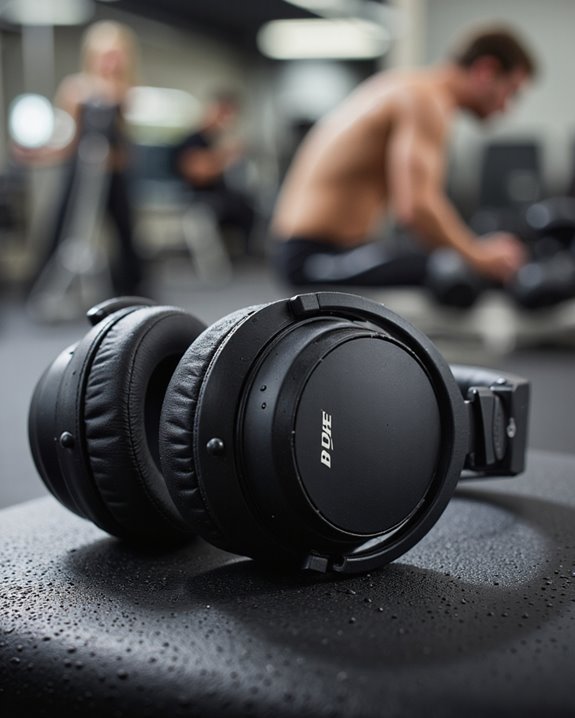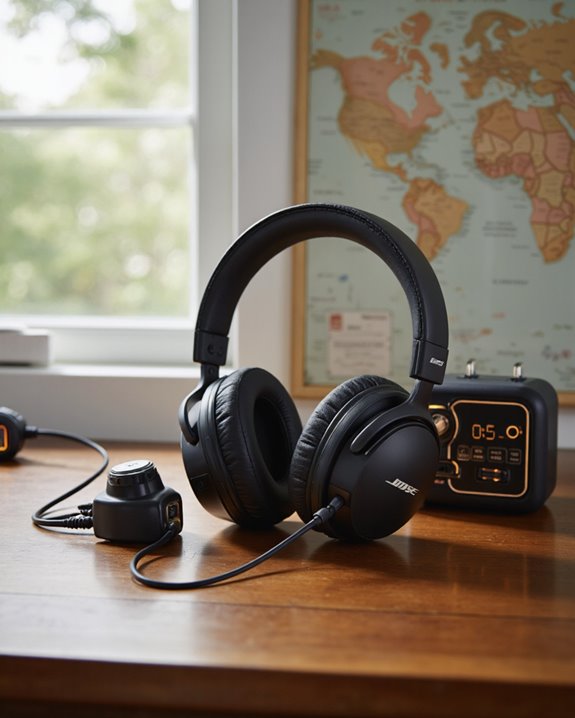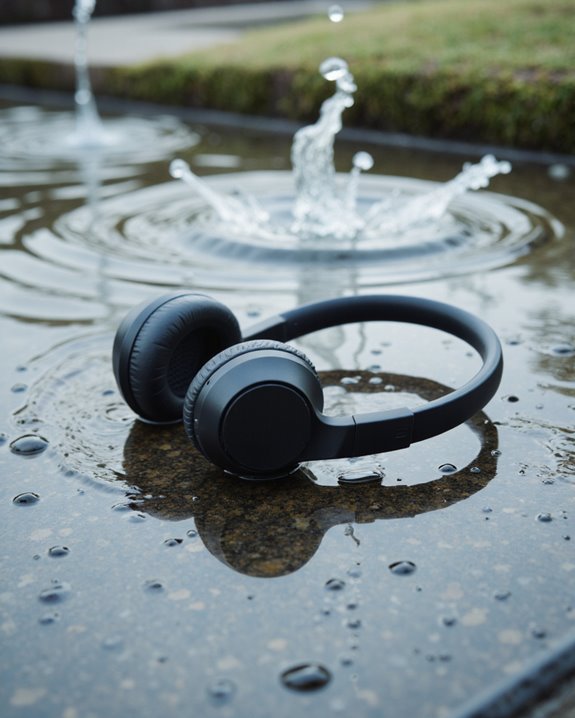As an Amazon Associate, we earn from qualifying purchases. Some links may be affiliate links at no extra cost to you. Although our opinions are based on curated research, we haven't used these products. Articles generated with AI.
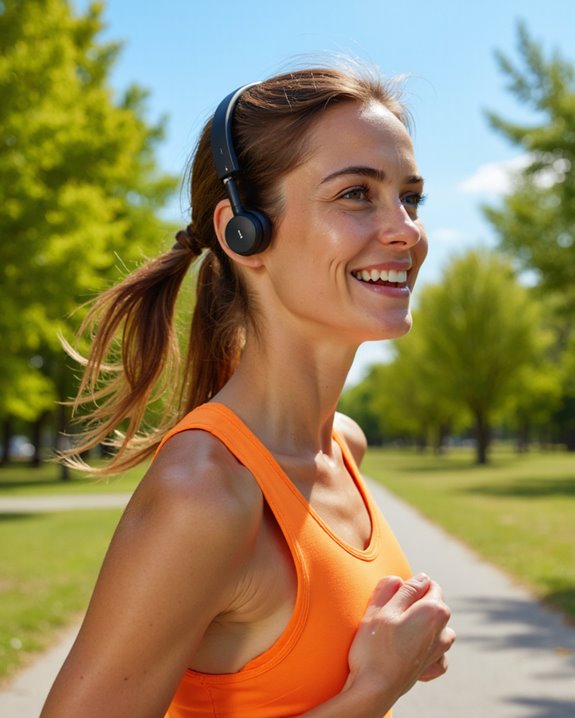
Can You Wear Headphones While Exercising?
We can wear headphones while exercising, as they boost motivation and focus—especially when music is played at safe volumes (ideally below 60% to prevent hearing loss). It’s important to choose models with a secure, sweat-resistant fit (look for IPX4 or higher ratings), and consider transparency or ambient mode features for environmental awareness during outdoor activities. However, in high-traffic or group settings, headphones can hinder safety and communication. There’s more to explore about effective and safe headphone use during workouts.
Key Takeaways
- Yes, you can wear headphones while exercising, and music can boost motivation and reduce perceived exertion.
- Use headphones with a secure fit and keep volume below 60% to protect hearing and maintain situational awareness.
- Avoid wearing headphones in high-traffic, unfamiliar, or group workout settings where safety and communication are critical.
- Prolonged or loud headphone use can increase risks of hearing loss, ear infections, and social isolation during exercise.
- Choose sweat-resistant headphones and activate ambient awareness features for safer and more durable workout use.
Benefits of Wearing Headphones During Exercise
Although many of us might view headphones as simple accessories, they’ve become essential tools for maximizing exercise performance. When we incorporate music into our workout routines, we see a measurable boost in motivation, making it easier to begin and maintain challenging sessions. Research demonstrates that music reduces perceived exertion, allowing us to push harder and longer by distracting from muscle pain and fatigue. The quality of sound delivered by modern headphones enhances the overall experience, providing crisp, immersive audio that keeps us engaged. By creating a focused auditory environment, headphones help signal our intent to concentrate, minimizing external distractions. Carefully curated playlists can further tailor motivation, ensuring our workouts remain enjoyable and effective, regardless of intensity or duration. Many models now offer IPX7 waterproofing, guaranteeing durability and performance even during intense sweat sessions.
Potential Risks and Drawbacks of Using Headphones
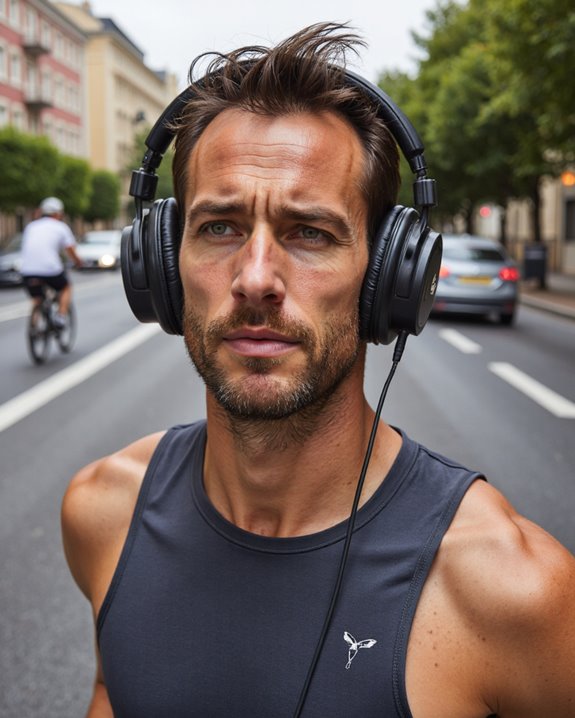
While headphones can enhance our workouts, it’s important to recognize several risks and drawbacks associated with their use. First, wearing earbuds or headphones can disconnect us from our environment, making us less aware of traffic or hazards—especially in urban settings where noise matters. Listening to music at high volumes directs intense sound into your ears, which may lead to hearing loss or affect balance over time. Extended use can also foster poor ear hygiene, increasing the risk of infections that might impact overall health. There’s also the potential for social isolation; headphones can separate us from group interactions, diminishing the communal workout feel. Finally, given that earbuds are small and often costly—ranging from $90 to $250—they’re easy to lose during vigorous activity. For those who want to protect their hearing while staying connected, Bluetooth hearing protection headphones can offer a balance of sound quality and noise reduction.
Safety Tips for Listening to Music While Working Out
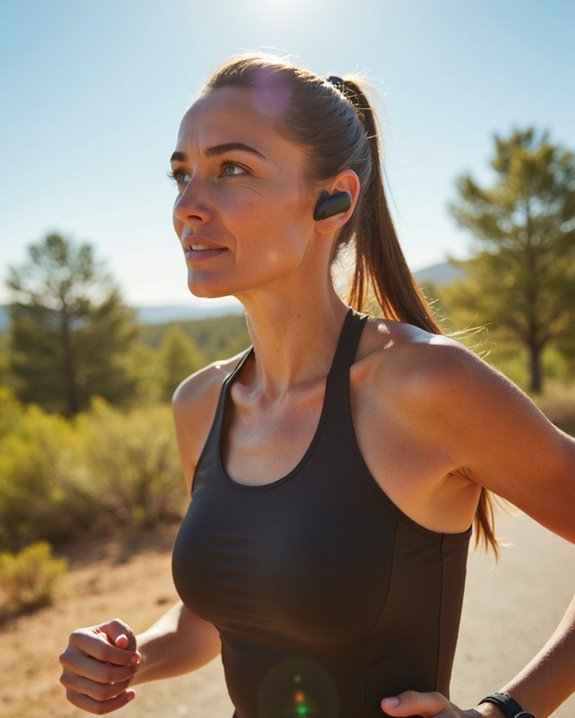
Staying safe while enjoying music during workouts requires a thoughtful approach to both equipment and environment. We should keep the volume at or below 60% to maintain awareness and protect hearing. Headphones with a secure fit, especially sports-specific designs, help prevent distractions from slipping or falling during movement. Transparent modes or ambient awareness features are valuable—these let us hear traffic, announcements, or other critical sounds. Opting for sweat- and water-resistant models, with a solid IP rating (such as IPX4 or higher), guarantees durability against moisture. While excellent sound is important, safety and practicality must come first. Finally, labeling our headphones with contact information can aid recovery if misplaced, given their compact size and portability during exercise. Choosing earbuds with secure-fit features like customizable eartips or earhooks ensures they stay firmly in place during vigorous activity.
How to Choose the Right Headphones for Exercise
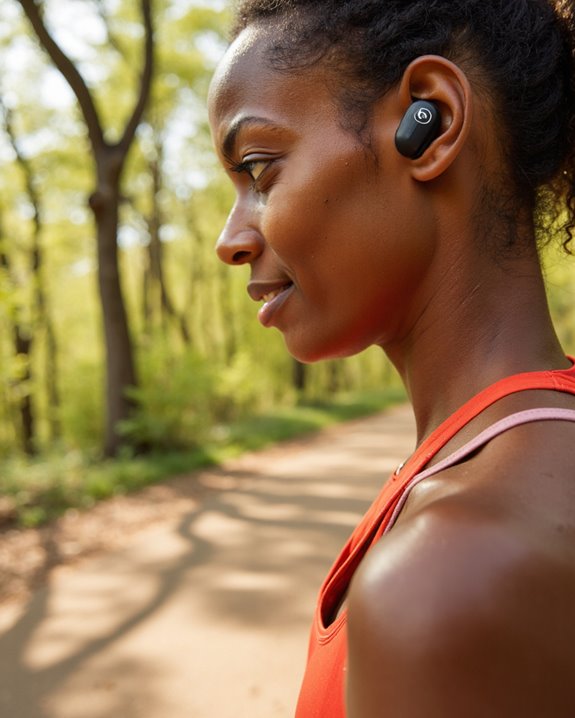
How do we determine which headphones truly match the demands of our exercise routines? To identify the best workout headphones, we should prioritize a secure fit—models with customizable ear tips guarantee they stay in place through vigorous movements. Battery life is another key factor; options like Raycon offering up to 38 hours minimize recharging interruptions. Water resistance, indicated by an IPX4 rating or higher, protects against sweat and rain, making headphones more durable for workouts. Audio quality matters too, since better sound can boost motivation. Comfort and ergonomics shouldn’t be overlooked—breathable materials and adjustable components can prevent irritation during long sessions. By systematically evaluating these features, we can confidently select headphones that optimize performance, resilience, and user experience during exercise.
Comparing Over-Ear vs. In-Ear Headphones for Fitness

Once we’ve identified the must-have features for workout headphones, it’s important to weigh the strengths and limitations of over-ear versus in-ear designs for fitness.
Over-Ear Headphones: These provide superior noise isolation and immersive sound, often enhancing our workout experience by blocking distractions. Larger battery capacity is another advantage—some models, like Raycon, offer up to 38 hours of playback, minimizing charging interruptions. Over-ear headphones usually guarantee a secure fit, reducing the need for frequent adjustments during exercise.
In-Ear Headphones: In contrast, in-ear headphones are lightweight and highly portable, ideal for high-intensity or on-the-go workouts. While they generally offer less noise isolation, their compact design can be more comfortable for some users. Sweat resistance varies, but many in-ear models are specifically engineered for fitness, guaranteeing durability and consistent performance.
Sweat and Water Resistance: What You Need to Know
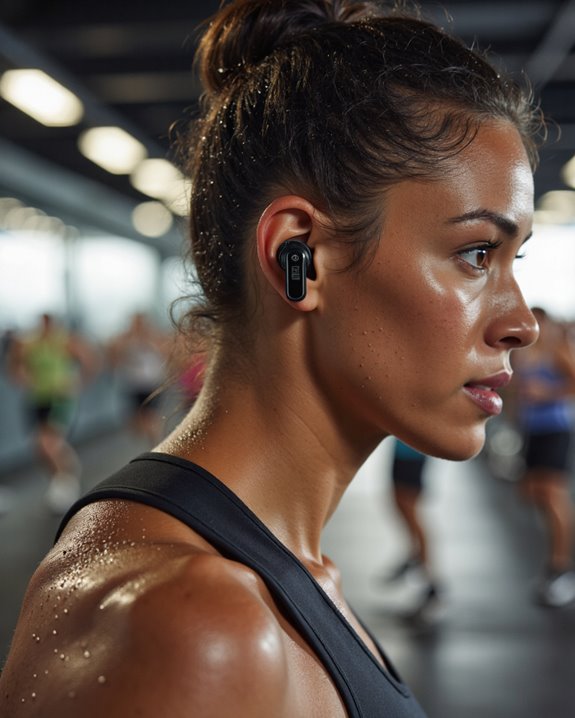
Although it might seem like a minor detail, understanding sweat and water resistance is essential when selecting headphones for exercise. Workout headphones with an appropriate IP rating help us avoid issues caused by moisture exposure, such as short-circuiting or diminished sound quality. The IP rating—a standardized measure—indicates how well a device resists sweat or water. For instance, IPX4 headphones offer general sweat resistance, protecting against splashes from any direction, which is suitable for most workouts. For aquatic activities, models like the Shokz OpenSwim with an IP68 rating deliver full water resistance, even during swimming. Additionally, many workout headphones incorporate corrosion resistance and quick-drying materials, further enhancing durability. Selecting headphones with adequate sweat and water resistance safeguards performance and extends device lifespan during intense activities.
Maintaining Hygiene and Preventing Hearing Damage
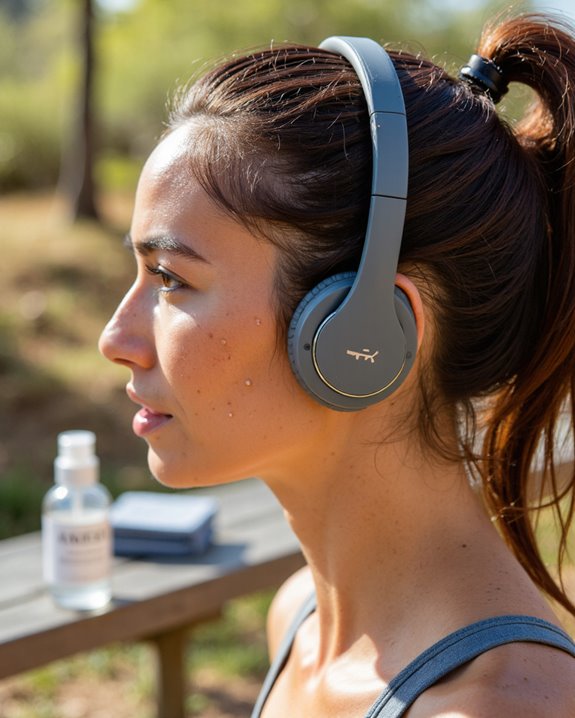
Proper hygiene and safe listening habits form the backbone of healthy headphone use during exercise. When we use earbuds or headphones during workouts, sweat and moisture buildup can quickly lead to bacterial growth, increasing the risk of ear infections. To maintain ear hygiene, it’s vital to clean headphones and ear tips after each session—using alcohol wipes or a gentle cleanser—to remove sweat, oils, and dirt. Choosing headphones with breathable materials also helps reduce moisture accumulation. We should periodically replace ear tips or cushions, as worn materials can harbor bacteria and cause irritation. Equally important is protecting our hearing; keeping the volume below 85 decibels and avoiding prolonged listening can greatly reduce the risk of hearing damage. Adopting these strategies guarantees safer, more hygienic listening experiences.
When to Avoid Using Headphones During Physical Activity

Even though headphones can make our workouts more enjoyable and focused, there are critical situations where it’s safer and more practical to leave them behind. For example, wearing headphones during outdoor activities—such as running in high-traffic areas or unfamiliar environments—can compromise our safety by reducing awareness of vehicles, cyclists, or potential hazards. In group settings, headphones often hinder communication, making it difficult to interact with others and diminishing the benefits of shared motivation and support. Additionally, if we’re participating in guided workouts or classes, headphones may cause us to miss essential verbal cues or instructions from an instructor. For trail running or exercising in nature, staying attuned to environmental sounds helps us respond to wildlife, uneven terrain, or changing weather promptly and effectively.
Frequently Asked Questions
Is It Okay to Wear Headphones While Exercising?
They say “music is the soundtrack of our lives.” We believe music motivation can boost workout focus and fitness enjoyment. Let’s balance auditory awareness and avoid sound distractions, though—personal preference matters, but safety should always come first.
Is It Better to Workout With or Without Headphones?
When deciding if it’s better to workout with or without headphones, we should weigh music motivation, focus enhancement, and workout intensity against the distraction factor and social interaction. Ultimately, personal preference and our environment play the biggest roles.
Is It Safe to Wear Headphones While Working?
They say, “Better safe than sorry.” When we wear headphones at work, safety concerns arise—reduced sound awareness can compromise injury prevention. Environmental factors matter, too. While headphones can enhance focus, let’s balance personal preference with workplace safety.
Is It Okay to Wear Airpods to the Gym?
When we wear AirPods to the gym, we enjoy comfort, great sound quality, and boosted workout motivation. Let’s remember gym etiquette, check for compatibility issues, and appreciate solid battery life to maximize our sessions safely.


